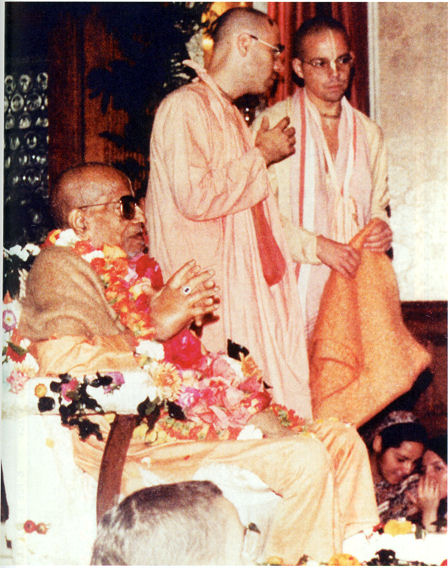
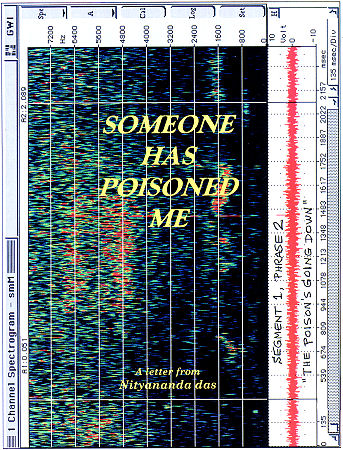
Download complete book as HTML ZIP-File
Download the E-Book: Someone has poisoned me
Someone Has Poisoned Me - BY: NITYANANDA DAS


Download complete book as HTML ZIP-File
Download the E-Book: Someone has poisoned me
The Facts About Srila Prabhupada's Poisoning by Arsenic
"So as Krishna was attempted to be killed... And Lord Jesus Christ was killed.
So they may kill me also." (Srila Prabhupada, May 3, l976, Honolulu)
"my only request is , that at the last stage don't torture me, and put me to death"
(from SPC Vol. 36, November 3, 1977 tape recorded Room Conversation)
[PLEASE NOTE: ADDRESSES, EMAILS, PHONE NUMBERS ETC. MIGHT NO LONGER BE CORRECT!]
CAE
1416-A Vassal-, NE
Albuquerque, NM 87106
(505)-268-0496
INVOICE
April 26, 1998 Nico Kuyt
Carolina's Vedic Village Society
re: Sri la Prabhupada Investigation
Phase two: Analysis
Materials:
Other:
subtotal: $6,453.43
Retainer paid: -$ 1,850.00
Total Due: $4,603.43
terms : COD
Computer Audio Engineering
1416-A Vassal-, NE
Albuquerque, NM 87106
(505)-268-0496
re: Srila Prabhupada investigation
Phase two: Analysis
Nico Kuyt
Carolina's Vedic Village Society
Summary
April 26, 1998
This investigation consisted of determining the dialog content of whispers, and the identification of possible areas of falsification. The procedures and findings are reported in separate attached reports.
When making a determination, the known manner of recording was considered. That manner was one being discontinuous: that is, of stopping recording, then re-engaging record mode. Thus many areas that may have been considered falsification attempts under other circumstances are clearly the normal manner of operating.
Designated as being of particular concern is the area from 11:56.484 to 23:01.360 of the May 1977 side A recording. After extensive examination of this area, it has been concluded that there is nothing to suggest any falsification in this area.
There are a few anomalies which could not be fully reconciled, as noted in the reports. These appear in areas which were not defined as being areas of concern. The remainder of the two tapes in question do not have indications of having been falsified.

Computer Audio Engineering
1416-A Vassar, NE
Albuquerque, NM 87106
(505)-268-0496
Procedure Report
re: Srila Prabhupada Investigation
Phase two: Analysis
Nico Kuyt
Carolina's Vedic Village Society
April 26, 1998
The assignment for phase two of the Srila Prabhupada investigation was that of analysis for the purpose of determining the dialog content of additional whispers which have been found, and to attempt to determine if the recordings have been falsified in any manner.
For this assignment new copies of the originals where provided by Paul Tombleson of the Bhaktivedanta Archives. The recordings are analog to digital transfers. The following information regarding the transfer procedure has been provided by Mr. Tombleson:
— beginning of e-mail —
Received: from cronus.host4u.net (root@cronus.host4u.net |209.150.128.18|) by kitsune.swcp.com (8.8.7/1.2.3)
with ESMTP id MAA09522 for <cae@swcp.com>; Fri, 27 Feb 1998 12:30:39 -07a) (MST)
Received: from 207.205.131.185 (Pool-207-205-131-185.atln.grid.net 1207.205.131.185|)
by cronus.host4u.net (8.8.5/8.8.5) with ESMTP id NAA08315 for <cae@swcp.com>; Fri, 27 Feb 1998 13:27:17 -06(X)
Message-1D: <34F70674.867422BC @ xenacom. net>
Date: Fri, 27 Feb 1998 14:31:18 -0400
From: Paul Tombleson <paul@xenacom.net>
Reply-To: paul@xenacom.net X-Mailer Mozilla 4.01 (Macintosh; I; PPC)
Ml ME-Version: 1.0
To: CAE Studio Jack Mitchell <cae@swcp.com>
Subject: Ready X-Priority: 3 (Normal)
Content-Type: text/plain; charset=as-ascii; x-mac-type=H54455854H; x-mac-creator="4D4F5353"
Content-Transfer-Encoding: 7bit
X-U1DL: 42d7228f3893f698c6b09b5l31 a()ec26
Dear Jack,
The 4 DAT's will be shipped to you on Monday (overnight UPS). Please keep an eye out on Tuesday.
Regards Paul Tombleson
Friday, February' 27, 1998
Procedures followed for transfer to DAT from original cassette tapes.
Original cassette tape 770528 and 771110 were played back on a Nakamichi CR-7A. These original tapes were played from the beginning of the tape including all of the leader tape. The recordings proceed until the very end of the original cassette tape including all of the end leaders. This was repeated for all four sides of the two original cassette tapes in question.
The recording DAT deck is a Sony PCM 2800. The recording was carried out as follows. The DAT deck was put in record and allowed to start. After approximately 5 seconds the Nakamichi CR-7A was started. When the recording's end (until the Nakamichi CR-7A came to a complete stop and disengages the head) approximately five seconds alter that the Sony DAT PCM 2800 was stopped (tape 771110 side A is approximately 25 seconds before DAT stopped).
— end of e-mail —
The above stated procedure is exactly as requested by CAE. It should be noted that these recordings where also recorded at the sample rate of 48Khz, which is the professional rate, rather the consumer rate of 44.1 Khz.. It should also be noted that these recordings, for the purpose of enhancement and speech decoding are most likely as good as having the original. The clarity on these digital copies exceeds the previously provided analog copies by magnitudes. However, for the purpose of authenticity it was made clear from the beginning by CAE that only a certain amount of reliable information could be obtained from copies and to achieve a reasonable scientific certainty regarding authenticity the original recordings would need to subjected to magnetic tape development and microscopic inspection. The originals have not been provided.
The digital tapes were then transferred digitally to the digital system. Each recording was thoroughly examined for areas of possible falsification, as well as for possible new information contained in whispers. Methods employed were critical listening, waveform analysis, energy analysis and spectrographic analysis.
Also provided for this phase of the investigation was the supposed original recording device, provided by Ralph Somershein, Bhaktivedanta Memorial Museum and Library. This device is a Uher CR210, sn: 1642 33955. Also provided was the original battery pack and supposed original microphone. This device was not operational when received and was repaired by CAE. The replaced parts have been preserved in case any additional device operation investigation is required.
Each aspect of this investigation is reported in a separate report.

Computer Audio Engineering
1416-A Vassar, NE
Albuquerque, NM 87106
(505)-268-0496
Uher CR210 Lab test
re: Srila Prabhupada Investigation
Phase two: Analysis
Nico Kuyt
Carolina's Vedic Village Society
April 26, 1998
Provided for this phase of the investigation was the supposed original recording device, provided by Ralph Somershein, Bhaktivedanta Memorial Museum and Library. This device is a Uher CR210, sn: 1642 33955. Also provided was the original battery pack and supposed original microphone. This device was not operational when received and was repaired by CAE. The replaced parts have been preserved in case any additional device operation investigation is required. It should be noted that the recording, playback and erase heads of this device were not cleaned so as to preserve as close as possible the functionality of the device as it was in 1977. This device was also given a complete series of performance tests to determine if any anomalies existed within the electronic circuit of the device. No anomalies were found. It is believed this device is as close to its operational state of 1977 as can be.
This device was then tested under a variety of conditions to simulate possible operation manner in order to obtain electronic machine signatures for comparison to those obtained from the recordings in question. The tests were carried out in accordance to the standards prescribed by AES (Audio Engineering Society) f or authenticity testing. That is, for each possible manner of operation, at least ten samples must be obtained. CAE obtained several hundred samples for analysis and comparison.
The possible manner of supplying power to this device is as follows:
I. This device will operate from a supplied battery pack, from six 1.5v batteries, from an internal power supply which fits into the battery compartment and is then plugged into an external wall outlet, or from an adapter which plugs into the back of the device and will bypass the battery circuit when in use.
a. Operation when using the battery pack could not be carried out due to the battery being dead.
b. Six 1.5v batteries were installed and it was found that this device works normally with these batteries. It is likely that the operation of this device using this means of power is the same as when using the supplied battery pack. A full set of tests were conducted using this method of providing power.
c. The use of an external rear fitting adapter was not possible due to it not having been provided.
d. Testing by supplying power from an inexpensive Archer (Radio Shack) AC/DC converter was carried out. The results of this test were unsatisfactory, with very prominent 60Hz hum being introduced into the recorded signal, as well as the start and stop procedures of the device being severely compromised. From this testing it was determined that such poor power supply could not have possibly been originally used and the lest results were ignored.
e. To simulate the use of an internal power supply, a BK 1670 DC laboratory power supply was connected to the terminals within the supply compartment. This proved to very satisfactory and a full set of tests were conducted using this method of delivering power.
The operation of this device is as follows:
1. Recording
a. This device records only in one direction. The auto-reverse is for playback only.
b. To engage record mode, the off/on selector must be in the off position. The record button must then be pressed in and held, the off/on selector then moved to the on (center) position, and finally the selector mast be moved to the right to engage the tape and begin recording. Moving the selector to the left engages nothing. It should be noted that the amount of pressure required to depress the record button will require either the device being braced in some manner or the use of two hands to engage record mode. This is a somewhat cumbersome procedure and could be prone to operator error. It should also be noted that the tape mast be properly inserted into the device for the record button to allow itself to be depressed. When the tape is inserted the device head assembly moves into contact with the tape, rather than being moved into contact when record mode is engaged.
c. To stop recording, the off/on selector must be moved to off (full up position), or pause mode must be engaged by moving the off/on selector downward. Neither manner of disengagement will cause the head assembly to move away from the tape. If pause/stop is used the capstans continue to rotate in anticipation of re-engagement, with the only mechanical movement being that of the pinch rollers moving away from the cassette.
d. To re-engage record mode from the pause/stop mode, the off/on selector is simply moved to the right. This re-engagement is nearly instantaneous, with recording beginning within approximately .003 sec.
e. Playback is engaged by moving the off/on selector to on, then moving the selector either left of right, depending on which side of the tape one wishes to hear (A or B). Moving the selector in the opposite direction from that which has been engaged causes an nearly instantaneous reversal. This has the potential of damaging the tape by causing stretching, binding, or perhaps breakage.
f. Fast-forward/rewind is engaged by moving the bottom lever either left or right. If record mode was engaged prior to using ff/rw, record mode is instantly disengaged. Use of the ff/rw lever disengages the head assembly from the tape. During testing it was noted that this lever can be moved approximately 1/32" before record mode is disengaged. This causes the head assembly to also move slightly and resulted in the audio anomaly of the recorded signal to playback at a slightly higher pitch and with some distortion during that segment. It should be noted that once during testing the movement of this lever caused the record mode to disengage, but the transport continued to operate, causing an audio gap in the tape.
Microphone:
The supplied microphone is Uher model M640. This is a double microphone, that is, separate microphones for left and right channel in one device which can be spread apart for channel separation. This device has a button on it which when depressed activates pause mode. When releasing the button record mode will restart. Testing of this button resulted in the anomaly of sometimes it worked, other times it did not. Also, movement of the connecting cord caused short circuiting and gaps in the audio.
Testing:
For each of the above stated methods of delivering power to the device, the following tests were conducted for the purpose of obtaining electronic machine signatures.
a. Start record - no audio, microphone disconnected
b. Stop record - no audio, microphone disconnected
c. Start record/stop/eject - no audio, microphone disconnected
d. Stop record/restart record - no audio, microphone disconnected
e. Pause record/eject - no audio, microphone disconnected
f. Pause record/restart record - no audio, microphone disconnected
g. Start record - with audio, microphone connected, amplitude set to 3/4 max.
h. Stop record - with audio, microphone connected, amplitude set to 3/4 max.
i. Start record/stop/eject - with audio, microphone connected, amplitude set to 3/4 max.
j. Stop record/restart record - with audio, microphone connected, amplitude set to 3/4 max.
k. Pause record/eject - with audio, microphone connected, amplitude set to 3/4 max.
l. Pause/restart record - with audio, microphone connected, amplitude set to 3/4 max.
m. Microphone pause/microphone restart
n. Also several samples where taken with the Automatic Level Control engaged.
o. The internal microphone was also tested. This produced extreme hum and distortion.
Results:
Examples of typical test signatures are attached to this report:
Exhibit 1: Three typical stop/restart of record mode signatures with audio being recorded by the device. Note the timing of .032 sec. This is very fast and very unusual for a recording device, many being as much as .650 sec. The CAE HK CD 491 studio cassette stop/restart time is approximately .350 sec.
Exhibit 2: Three typical pause/restart of record mode signatures with audio being recorded by the device. Note the introduction of noise, as shown just to the right of marker 1, followed by magnetic pulsing prior to marker 2 (large spikes). Note the sequence time of .00375 sec. This is very fast and very unusual. The CAE HK CD 491 studio cassette pause/restart time is approximately .150 sec.
Exhibit 3: Three typical slop of record mode signatures with audio being recorded by the device. The timing of approximately .313 sec. is typical of recording devices.
All electronic signatures arc subject to some variation due to the manner of the operator, and the amount of current being drawn by the device. The Uher CR 210 varied in its current draw from .21 amp to .71 amp during operation switching.

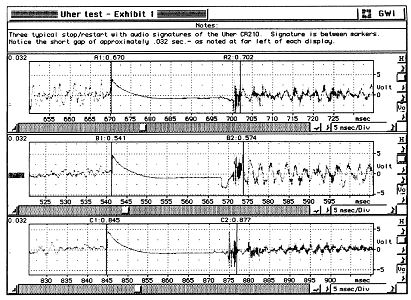
Audio Spectrographic Analysis: - Exhibit 1
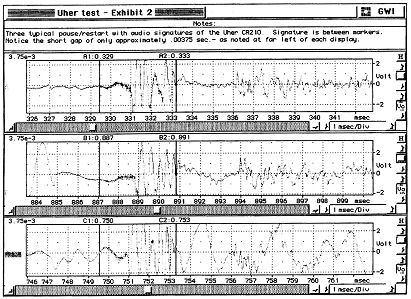
Audio Spectrographic Analysis: - Exhibit 2

Audio Spectrographic Analysis: - Exhibit 3
Computer Audio Engineering
1416-A Vassar, NE
Albuquerque, NM 87106
(505)268-0496
Tape 77771110 - November 1977 - Side A
re: Srila Prabhupada investigation
Phase two: Analysis
Nico Kuyt
Carolina's Vedic Village Society
April 26, 1998
This report will list, with timing, audio events which may be misleading to the listener, as well as other relevant audio events. Supporting graphics for some events are attached.
It should be noted that the stated timings are those in the CAE digital system. Timing begins with the inclusion of 5-6 sec. of leader. All stated timing should be within a second or two on any system.
Side A
Beginning: The recording begins by having had record mode engaged in the leader section, thus there is no expected electronic start signature. This abrupt beginning times perfectly with the clearly defined end of the beginning leader.
Ending: The recording ends by continuing in record mode into the tail leader section, thus there is no expected electronic stop signature. This abrupt ending times perfectly with the clearly defined beginning of the tail leader.
0:20.952 - Movement of the microphone, nothing unusual.
0:38.049 - Movement of the microphone, nothing unusual.
0:43.432 - Thump: audible movement, most likely a hit on the mic. No ambient discontinuity.
0:57.692 - Whisper Going down
1:02.841 - Movement of the microphone, nothing unusual.
1:26.153 - Voice l: [tisk], Voice 2: Um-hm (affirmative response)
1:34.717 - Mic hit; no ambient change.
1:37.051 - Mic movement; no ambient change
1:42.800 - Thump - cause unknown; no ambient change - distant voices are continuous.
2:00.000 - Segment 1; as reported in report dated January 25, 1998
2:23.646 - Very low amplitude anomaly; sounds like the word |poison| but is actually an audio illusion. 2:25.212 - Stop/start routine - Exhibit 1
Exhibit 1 - There is some time variation from the test signatures, but the overall structure is consistent with the CR 210. A small amount of magnetic pulsing can be seen at approximately 881ms of signal A. Signal B (test signal) has magnetic pulsing at approximately 573 ms.
3:22.667 - Mic thump
3:25.232 - Whisper - Did it hurt?
3:58.135 - Mic hit
4:11.898 - Segment 2; as reported in report dated January 25, 1998
4:23.035 - Mic hit
4:58.493 - Whisper - Discuss it.
6:04.405 - Click; cause unknown - seems to be an acoustic event, not an edit; no ambient change.
6:53.655 - Series of clicks; acoustic event, not edits; perhaps necklace or bracelet worn by speaker.
7:23.865 - Whisper - Take that.
8:38.931 - Whisper - [That's] really good.
10:46.970 - Mic movement; hum momentarily introduced.
13:11.902 - Stop/start routine - Exhibit 2
Exhibit 2 - Signal A shows a double signature. Signal B is a close view of the second signature of signal A. This shows a pause/restart signature consistent with the Uher CR 210, as shown in signal C. The cause of this double signature may be that of operator error or an unidentified device anomaly. It does not appear to be a point of edit, appears to be consistent with the known manner of recording, and there is no evidence of falsification between the previous stop/start routine and this one. However, this area should be considered as not being fully reconciled.
13:20.414 - Mic movement
21:19.824 - Probable mic hit; more prominent in left channel 21:39.418 - Whisper - He's gonna die.
21:58.641 - Whisper - Listen, he's saying__going to die.
25:49.931 - Whisper - This one |carcs/carrics| |of you/our view).
26:04.608 - Snap/pop - Sounds like biting into hard food. Can hear Prabhupada speaking with what sounds like food in mouth.
27:24.134 - Segment 3; as reported in report dated January 25, 1998
27:50.971 - Two background speakers, covered by primary speaker - Voice 1: It looks to me he's stupid. Voice 2: Looks that way, yeah.
28:51.451 - Probable mic hit; more prominent in left channel
29:41.301 - Pop/tap - perhaps tapping of mic cord; more prominent in left channel, no ambient change. 30:33.817 -Pop/tap - perhaps tapping of mic cord; more prominent in left channel, no ambient change.
30:42.161 - Pop/tap - perhaps tapping of mic cord; more prominent in left channel, no ambient change.
33:13.591 - Mic movement 33:36.017 - Soft voice - That's funny.
33:41.816 - Whisper - Let's go out.
34:12:.770 - Segment 5; as reported in report dated January 25, 1998
34:54.432 - Background speaker, covered by primary speaker - (unintelligible!) (Pra-bu) shouldn't talk too much, bad for his heart.
35:03.237 - Soft voice - (unintelligible) energies conserved and built up, and managed, and (unintelligible) 35:19.957 - Whisper - Let's |redeem ourselves|.
35:32.474 - Voices buried beneath singer, perhaps two speakers - Did you drink? How many?
35:38.900 - Stop routine - Exhibit 3 and 3a
Exhibit 3: This is a clear match of the recorded signal (A) and the test signal (B).
Exhibit 3a: Shows full sequence between Exhibit 3 and Exhibit 4. The 3.903 sec. gap is unusual but may have been caused by the operator intentionally fast-forwarding the recording, or by operator error. As reported in the Uher CR 210 report, the operation of this device is somewhat awkward. The fast-forward selector is positioned in such a location that it could easily by moved by mistake. There is nothing in this area to suggest an edit.
35:42.683 - Start routine - Exhibit 4
Exhibit 4 - Signal A shows no expected start signature. Signal B is a CR 210 start routine when operated with batteries. There is no expected start signature.
35:43.843 - Amplitude drop and change of program material - Exhibit 5
Exhibit 5 -This area was initially thought to be an area of edit. A close views of this area shows a consistency with the CR 210 pause/restart routine. Signal A is the recorded signal. Signal B is the test signal.
36:21.023 - This area was initially thought to be an area of edit. A close views of this area shows a consistency with the CR 210 pause/restart routine. No exhibit included.
36:22.433 - This area was initially thought to be an area of edit. A close views of this area shows a consistency with the CR 210 pause/restart routine. No exhibit included.
39:51.044 - Mic movement
41:14.772 - Mic movement
44:42.363 - Whisper - God damnit |Jay's| unintelligible! oh, god.
44:45.671 - Whisper - God damn (unintelligible) ......|...strie| |long|.
44:57.924 - Whisper - Fifty percent's your cut. — This has been designated as Segment 6. Spectrograhic display yields no useful information.
45:49.403 - Low voice - Well, no good reason.
46:08.663 - Whisper - (unintelligible) you doin'?
46:51.445 - Whisper - Yes, a heart attack time.
Recording ends
Conclusion
This recording has one area that cannot be fully reconciled. As for the remainder of the recording, from the evidence obtained from the recordings provided for analysis, there arc no clear indications of falsification. The electronic signatures obtained from this recording are consistent with the Uher CR 210, appear to be consistent with the known manner of recording, and audio event anomalies have been satisfactorily accounted for.

Computer Audio Engineering
1416-A Vassar, NE
Albuquerque, NM 87106
(505)268-0496
Tape 77771110 - November 1977 - Side B
re: Srila Prabhupada Investigation
Phase two: Analysis
Nico Kuyt
Carolina's Vedic Village Society
April 26, 1998
This report will list, with timing, audio events which may be misleading to the listener, as well as other relevant audio events. Supporting graphics for some events are attached.
It should be noted that the stated timings are those in the CAE digital system. Timing begins with the inclusion of 5-6 sec. of leader. All stated timing should be within a second or two on any system.
SideB
Beginning: The recording begins by having had record mode engaged in the leader section, thus there is no expected electronic start signature. This abrupt beginning times perfectly with the clearly defined end of the beginning leader.
Ending: The recording ends by continuing in record mode into the tail leader section, thus there is no expected electronic stop signature. This abrupt ending times perfectly with the clearly defined beginning of the tail leader.
3:47.884 - Whisper - Do it again.
4:42.435 - not clear, might be - |God damn|
5:10.565 - not clear, might be - Try to (2 syllables; unintelligible)
5:19.562 - Whisper - [unintelligible] [last night/that's right] maybe we [unintelligible]
5:33.228 - Whisper - unintelligible
6:19.807 - Whisper - unintelligible
6:37.573 - Mic hit, no ambient change
14:30.425 - Whisper - unintelligible
17:05.650 - Whisper - Stay here.
20:04.564 - Whisper - Somebody could expect |to have| experience |unintelligible|.
21:11.073 - Mic hit; no ambient change
21:18.931 - Low voice - Check these thing and |unintelligible|.
21:25.878 - Low voice - I told you what's going on. Ordered to |2 unintelligible syllables|. He's as |sly/slay| as they |come/go|.
Note: |sly/slay | - this sounds like a combination of /ei/ and /y/. Most likely this is the speakers dialect for the word /sly/. |come/go| - this is covered by a considerable amount of interfering sounds and could not be completely deconvolved.
22:04.049 - Stop/start routine - Exhibit I
Exhibit 1 - Signal A reveals a strange stop/restart sequence. However, a close view of the second spike (signal B) shows a close similarity to the known pause/restart routine of the Uher CR 210.
This double signature may be caused by operator error (perhaps beginning one method of disengagement but transferring to another method before completion), or by some unidentified device anomaly. Also, the initial area of disengagement is consistent with the Uher disengagement test signals. This signal is also very similar to that found at 37:48.842 (Exhibit 4). Since the two signals are so similar, it is likely that this is a device anomaly, appears to be consistent with the known manner of recording, and there is no evidence of falsification between the beginning of the recording and this stop/start routine. However, it should be noted that this area should be considered as not being fully reconciled.
23:21.126 - Whisper - Like |this/his| last time out.
25:58.572 - Snap - unknown room sound; wall reflection and be heard.
28:34.295 - Stop/start routine - Exhibit 2
Exhibit 2 - This area is consistent with the known pause/restart routine of the Uher CR 210. Due to the quickness of the routine this could be misconstrued as an edit. It is not.
28:44.747 - Two soft voices - Voice 1: Could of been ten percent of it. Voice 2: Can you buck the (unintelligible).
29:59.811 - Mic movement
30:04.808 - Low voice - unintelligible
31:35.191 - Clicks - seems to electronic, perhaps line transient; no ambient discontinuity.
34:05.335 - Clicks - seems to electronic, perhaps line transient; no ambient discontinuity.
35:14.459 - Segment 4; as reported in report dated January 25, 1998
35:43.674 - Segment 4 - new material:
Voice: You're taking it right now.
Prabhupada: How's this? ... Let it go.
36:24.682 - Stop/start - Exhibit 3
Exhibit 3 - The original signal (A) reveals a odd double signature. Close examination and comparison to the known stop routine of the Uhcr CR210 (signal B) reveals the existence of that known signature. The presence of a double signature cannot be satisfactorily reconciled, although there is no evidence of falsification between the previous stop/start (28:34.295) and this one.
37:48.842 - Stop/start - Exhibit 4
Exhibit 4 - Signal A reveals a strange stop/restart sequence. This area is very similar to 22:04.049 - Exhibit 1. Once again, a close view of the second spike (signal B) shows a close similarity to the known pause/restart routine of the Uher CR 210. This double signature may be caused by operator error (perhaps beginning one method of disengagement but transferring to another method before completion), or by some unidentified device anomaly. Also, the initial area of disengagement is consistent with the Uher disengagement test signals. Since Exhibit 1 and Exhibit 4 arc so similar, it is likely that this is a device anomaly, appears to be consistent with the known manner of recording, and there is no evidence of falsification between the previous stop/start (36:24.682) and this one. However, it should be noted that this area should be considered as not being fully reconciled.
Recording continues to the end leader without any events which needed to be documented.
Conclusion
This recording has three stop/start routines that cannot be fully reconciled. As for the remainder of the recording, from the evidence obtained from the recordings provided for analysis, there are no clear indications of falsification. The electronic signatures obtained from this recording arc consistent with the Uher CR 210, appear to be consistent with the known manner of recording, and audio event anomalies have been satisfactorily accounted for.

Computer Audio Engineering
1416-A Vassar, NE
Albuquerque, NM 87106
(505) 268-0496
Tape 770528 - May 1977 - Side A
re: Srila Prabhupada Investigation
Phase two: Analysis
Nico Kuyt
Carolina's Vedic Village Society
April 26, 1998
This report will list, with timing, audio events which may be misleading to the listener, as well as other relevant audio events. Supporting graphics for some events are attached.
It should be noted that the stated timings are those in the CAE digital system. Timing begins with the inclusion of 5-6 sec. of leader. All stated timing should be with a second or two on any system.
Note: The electronic signatures of this recording do not match the test signatures of the Uher CR 210. However, the signatures of this recording arc consistent among themselves. This would be consistent with a different recording device having been used for this recording.
Side A
Beginning: The recording begins by having had record mode engaged in the leader section, thus there is no expected electronic start signature. This abrupt beginning times perfectly with the clearly defined end of the beginning leader.
Ending: The recording ends by continuing in record mode into the tail leader section, thus there is no expected electronic slop signature. This abrupt ending times perfectly with the clearly defined beginning of the tail leader.
0:13.450 - Two energy drops. There is clearly audible microphone movement at this point. The energy drops are most likely caused by a momentary short circuit caused by the mic movement. The speech formant structure seems to be continuous.
1:51.792 - Low voice - We're going back |home|.
2:12.707 - Sudden drop of amplitude combined with ambient change and apparent change of location. It is believed this seemingly odd recording anomaly is caused by the cassette having been removed from the recording device, reinserted without exact previous alignment (which is the normal case), then engaging record mode of the device. When record mode was re-engaged it partially erased the last few words of the previous phrase, but not totally. This caused a seeming instantaneous start of the next section. There are two slight audible thumps, but an satisfactory analysis reading could not be obtained. This does not appear to be a point of edit. This anomaly was easily reproduced on the CAE HK CD 491 studio cassette recording device.
11:52.462 - Stop/start - Exhibit 1
11:56.484 - Stop/start - Exhibit 1
Exhibit 1 - These two signatures do not match the test signature of the Uher CR 210, as shown in Exhibit 1. However, they do match each other and are consistent with the known normal recording procedure.
15:47.106 - Fan turned off - this is a natural occurrence. The amplitude of the fan noise can be heard decreasing for about 8 sec. This is not an edit.
17:41.900 - Fan turns on - this is a natural occurrence. This is not an edit.
18:49.167 - Birds - Sounds like whispers. Combination of bird chirps and fan noise creates the audio illusion of whispers. There are other such occurrences in this section.
21:21.860 - Fan turns off - this is a natural occurrence.
21:28.684 - Whisper - That's all.
23:01.360 - Stop/start - Exhibit 2
Exhibit 2 - Signal A is the electronic signature from this area. It is a match with 11:56.484 from this same recording. This is consistent with the known normal recording procedure.
Note that it does not match with the Uher CR 210 test signature.
29:28.392 - Loud click - this is an acoustic event in the room, perhaps somebody bumping something. 37:28.857 - Clicks - Exhibit 3
Exhibit 3 - This area sounds like a stop/start routine, but is not. This is most likely somebody using a stapler near the microphone. The stapler spring-back is clearly audible. There also is not the expected gap caused by a stop/start or pause/start routine.
43:30.316 - Clicks - Exhibit 3
43:49.217 - Clicks - Exhibit 3
Exhibit 3 - The above two areas are also shown in Exhibit 3. Notice the similarity of timing, amplitude and overall general signal features with that of signal A. Again, this is most likely somebody using a stapler near the microphone. This area sounds like a stop/start routine, but is not. There also is not the expected gap caused by a stop/start or pause/start routine.
44:57.405 - Clicks - Exhibit 4
45:32.419 - Clicks - Exhibit 4
Exhibit 4 - The above two areas are very similar to Exhibit 3. Again, this is most likely some body using a stapler near the microphone. This area sounds like a stop/start routine, but is not. There also is not the expected gap caused by a stop/start or pause/start routine.
Audio ends
Conclusion
From the evidence obtained from the recordings provided for analysis, there are no clear indications of falsification. Although the electronic signatures obtained from the recording do not match the Uher CR 210, the majority of electronic signature features are consistent among themselves, appear to be consistent with the known manner of recording, and audio event anomalies have been satisfactorily accounted for.

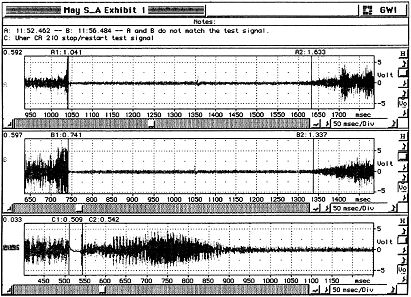
Spectrograhic display Exhibit 1
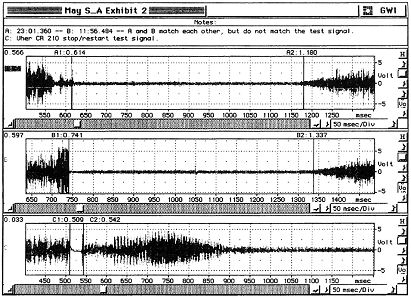
Spectrograhic display Exhibit 2
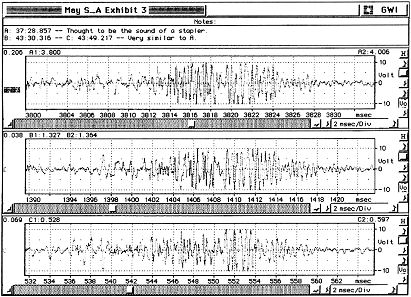
Spectrograhic display Exhibit 3
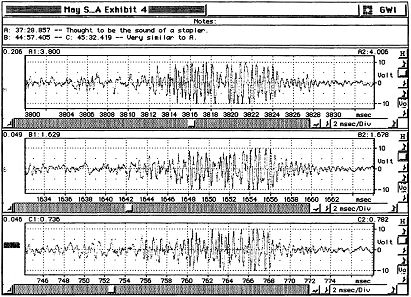
Spectrograhic display Exhibit 4
Computer Audio Engineering
1416-A Vassar, NE
Albuquerque, NM 87106
(505)-268-0496
Tape 770528 - may 1977 - Side B
re: Srila Prabhupada Investigation
Phase two: Analysis
Nico Kuyt
Carolina's Vedic Village Society
April 26, 1998
This report will list, with timing, audio events which may be misleading to the listener, as well as other relevant audio events. Supporting graphics for some events are attached.
It should be noted that the stated timings are those in the CAE digital system. Timing begins with the inclusion of 5-6 sec. of leader. All stated timing should be with a second or two on any system.
Note: The electronic signatures of this recording do not match the test signatures of the Uher CR 210, nor do they match side A of tape 770528. However, the signatures of this recording arc for the most part consistent among themselves, with the exceptions noted below. This would be consistent with a different recording device having been used for this side of the recording, or some sort of current delivery anomaly.
SideB
Beginning: The recording begins by having had record mode engaged in the leader section, thus there is no expected electronic start signature. This abrupt beginning times perfectly with the clearly defined end of the beginning leader.
Ending: The recording ends 8.483 sec. before tail leader section. Expected stop signature is present.
0:06.251 - Mic hit
2:34.901 - Stop/start - Exhibit 1
Exhibit 1 - Signal A is the electronic signature from this area It does not match signal B - typical stop/start from side A, or signal C - typical stop/start test signal of the Uher CR 210.
2:40.422 - Stop/start - Exhibit 2, 2a, 2b
Exhibit 2 - Signal A is the anomaly from this area. It does not show an expected gap caused by normal stop/start or pause/restart routines. Signal B is a typical pause/restart routine test signal of the Uher CR 210. Signal C is a typical stop/start routine test signal of the Uher CR 210. Signal A does not match either test signal, nor was any similar signal found in this recording.
Exhibit 2a - Spectrogram of the area in question. No signature or gap present. There is a clear difference in the frequency content after the anomaly.
Exhibit 2b - Close spectrographic view of the anomaly. No gap present. There is a clear difference in the frequency content after the anomaly.
Shown in Exhibit 2a is a sudden upward movement of frequencies, which abruptly ends. This is an indication of cither user error or an electronic anomaly within the recording device. This is clearly audible. There being no electronic stop/start signature or the expected gap, combined with an abrupt change in frequency content is usually associated with areas of intentional falsification. However, due to the sudden upward movement of the frequencies just prior to the abrupt change, operator or machine error is strongly indicated. This area cannot be fully reconciled.
9:03.535 - Stop/start - Exhibit 3 (see 11:52.969)
9:53.464 - Stop/start - Exhibit 3 (see 11:52.969)
11:33.891 - Whisper - 4 syllables with 2 clear /s/ locations. Cannot hear clearly, but might be - |it's really so|.
11:52.969 - Stop/start - Exhibit 3
Exhibit 3 - These three signal are very similar with regard to their major features. They are also very similar to the major features of signal A of Exhibit 1. Signal A of Exhibit 3 has audio entrance earlier than the other signals. This cannot be fully explained but may be due to this being a pause/restart routine rather than a full stop/start. That is of course speculation, but the major features are the same and there is no indication of falsification between the three stop/start routines. Signal A cannot be fully reconciled.
11.56.136 - Mic movement
14:33.148 - Mic movement
15:18.531 - Beginning at this point and continuing for a considerable length, there are a series of odd clicks. This seems to be somebody tapping something, not points of edits.
21:21.510- Whisper - unintelligible
23:36.197 - Movement close to microphone
28:07.112 - Gap/thump - Exhibit 4,4a
Exhibit 4 - Three areas of dropout where found on this recording. As shown in the exhibit, all three areas are very similar. This type of anomaly is caused by:
Exhibit 4a - Spectrogram of gap. Shows clear consistency of frequency content on either side of the gap. This is not likely to be an area of falsification.
29:20.342 - Stop/start - Exhibit 5
Exhibit 5 - Signal A is the signature from this area It is compared to 11:52.969 of this same recording. The major features arc the same.
30:27.563 - Gap/thump - Exhibit 4,4b
Exhibit 4-(sec 28:07.112)
Exhibit 4b - Spectrogram of gap. Shows clear consistency of frequency content on either side of the gap. This is not likely to be an area of falsification.
32:42.006 - Click (see 15:18.531)
33:58.645 - High frequency drop - movement in room; likely cause is blockage of microphone.
38:43.524 - Thump - Seems to be a natural room acoustic event.
40:58.779 -Click -Exhibit 6 41:03.163-Click-Exhibit 6
Exhibit 6 - the above two areas have been linked to side A, 37:28.857, of this recording. Again, this seem to be consistent with the use of a stapler near the microphone.
42:52.520 - Stop/start - Exhibit 7 (see 43:37.253)
42:55.686 - Frequency change - microphone position changed
43:37.253 - Stop/start - Exhibit 7
Exhibit 7 - Signal A and B show similar major features to signal C, 2:34.901, of this recording. These appear to be normal stop/start routines.
45:40.168 - Gap/thump - Exhibit 4, 4c
Exhibit 4 - (see 28:07.112)
Exhibit 4c - Spectrogram of gap. Shows clear consistency of frequency content on either side of the gap. This is not likely to be an area of falsification.
46:43.817 - Stop/start - Exhibit 8
Exhibit 8 - The electronic signature of this area does not fit with any known signature. The frequency content on either side of the event is considerably different. This is most often associated with intentional falsification. This event comes within a few seconds of the end of the recording and thus falsification at this point makes no sense to this investigator. This area cannot be reconciled.
End of audio with expected stop signature.
Conclusion
This recording has three areas that cannot be fully reconciled. As for the remainder of the recording, from the evidence obtained from the recordings provided for analysis, there are no clear indications of falsification. The majority of electronic signature features are consistent among themselves, appear to be consistent with the known manner of recording, and audio event anomalies have been satisfactorily accounted for.

Srila Prabhupada left this mortal world on November 14, 1977.
But He lives forever in His instructions, and His followers will always live with Him.
"He reasons ill who tells that Vaishnavas die
While thou art living still in sound!
The Vaishnavas die to live, and living try
To spread the Holy Name around"
(Śrīla Bhaktivinoda Thākura)
HARE KṚṢṆA HARE KṚṢṆA KṚṢṆA KṚṢṆA HARE HARE
HARE RĀMA HARE RĀMA RĀMA RĀMA HARE HARE